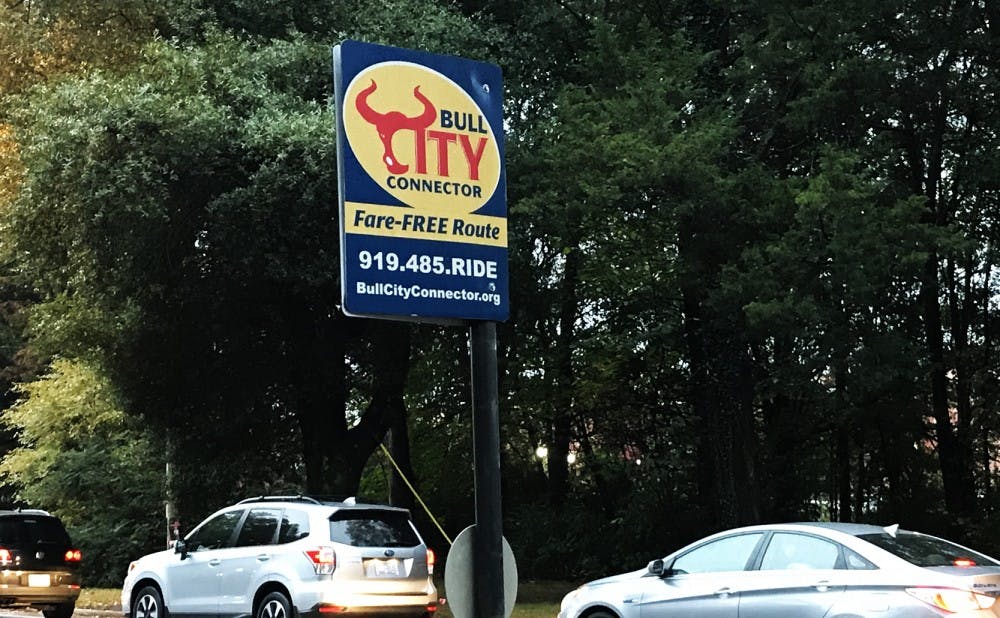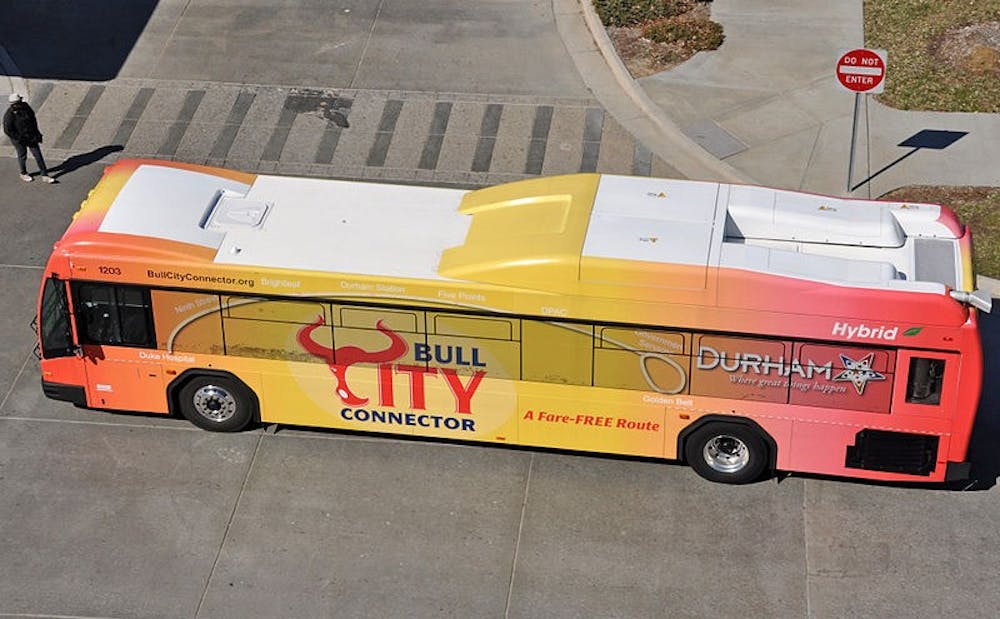For years, Bull City Connector buses have traversed Durham’s Main Street, offering fare-free transportation from Duke’s campus to the heart of the city.
But with the University pulling its funding from the service and GoTriangle, the transit provider that controls the route, and conducting a study to consider changes to its routes, the future of the BCC is unclear. The University has plans to create a shuttle service downtown for students and employees to better serve their demands, but Liz Brown, Duke Student Government vice president for Durham and Regional Affairs, says that the BCC is more about making Duke accessible to the community than getting students into Durham.
As of right now, however, no changes to the route have been announced.
“At this point, we don’t have any big concerns [about the BCC route],” said Terry Bellamy, director of the city’s transportation department. “We’ve gone through the study process and updated the five-year transit plan, and at this point we want to hear from the users and hear what they think about the service.”
The idea for the BCC was born in 2008 as a pilot project from Durham city manager Tom Bonfield and Phail Wynn Jr., Duke’s vice president of the Office of Durham and Regional Affairs. Bonfield had found $3.75 million earmarked to help the city buy six new hybrid diesel buses, and Duke was asked to pitch in $375,000 to help the city match the funds, Wynn said. After that, the two came up with the idea for the pilot program and Duke began paying $350,000 per year for the BCC. The route started in 2010 and was supposed to run for three years so they could see how it went, Wynn said.
Wynn said that he was concerned with providing employees a way back to campus without them having to use cars as Duke moved more and more employees downtown, and he saw the BCC as a way to reduce the local carbon footprint and encourage students to get further into Durham and engage with the city.
Although the goal for the route had been to service 2,000 riders per day, it struggled to meet that threshold, Wynn noted.
“As much as we tried to bolster the shuttle and make it more accommodating to Duke employees, we still were not meeting the needs of all our users,” he said.

Now, Duke’s redirecting its funding from the bus into a shuttle for Duke students and employees into downtown. The University has cut its $350,000 of funding for the BCC in half for this year, and is ending it completely for fiscal 2018.
“We are now taking those funds from the Bull City Connector to transfer them over to subsidize the new van service for students and employees downtown,” Wynn said.
The new service comes in response to students in Pratt School of Engineering and Innovation and Entrepreneurship classes needing to access facilities downtown during odd hours, but Wynn said it will “probably be open to students and staff in general.” Kyle Cavanaugh, vice president for administration, wrote in an email that the current status of creating the shuttle is that “conversations continue with various constituencies to further define needs, potential options, and funding requirements.”
As for the effect that Duke’s funding shift will have on Durham residents, Bellamy said GoTriangle’s evaluation of routes looks at more than just funding sources when considering the future of routes.
“We look at funding, but the contribution that Duke was making to the service was only a fraction of what it actually, truly costs,” he said.
In total, the route costs about $1.1 million to operate, according to an Indy Week report.
For Brown, the issue is not about getting Duke students into downtown, but rather about making sure that Duke is accessible to Durham residents.
“I don’t think the Bull City Connector should be about connecting Duke students to Durham,” Brown said. “I think the Bull City Connector is about connecting Durham residents to Duke.”
She said that she found out that Duke was pulling its funding via the Indy Week article, and said that she’s concerned that it seemed to be done under wraps. Brown said she is meeting with Wynn next week to discuss the University’s motivations for pulling the funds, but says the issue might be one she wants to bring before DSG to get a student say in the matter.
She said that pulling the funds is an example of Duke taking a step back when it should be taking a step forward.
“I think that Duke is always looked at critically, and rightfully so, by Durham. Duke’s relationship with Durham is fraught,” Brown said. “Duke has done a lot to maintain and improve that relationship and to make sure that we are being good stewards and good neighbors. I think we should do more.”
Wynn said that he sees the route changing in the future to meet the changing dynamics of the city.
“Actually, what I expect to see is the [BCC] becoming both a connector and a circulator—connecting to downtown and circulating around downtown,” he said.
Bellamy said that the city will use the transit study and user feedback to figure out if the route can better serve the city with modifications. With the impending addition of the Durham-Orange light rail, the transit scene in Bull City is changing rapidly, he noted.
“Over the next five to ten years, we’re going to see the Durham-Orange light rail come into play,” Bellamy said. “During that same period we’re going to see continued innovation in the way that transportation is being provided—not only in Durham, but across the country.”
Get The Chronicle straight to your inbox
Signup for our weekly newsletter. Cancel at any time.
Bre is a senior political science major from South Carolina, and she is the current video editor, special projects editor and recruitment chair for The Chronicle. She is also an associate photography editor and an investigations editor. Previously, she was the editor-in-chief and local and national news department head.
Twitter: @brebradham
Email: breanna.bradham@duke.edu

